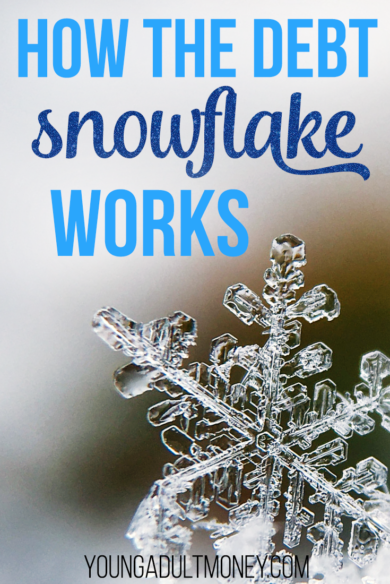 If you are a personal finance fiend, you may be familiar with both the debt avalanche and the debt snowball method of paying off debt.
If you are a personal finance fiend, you may be familiar with both the debt avalanche and the debt snowball method of paying off debt.
But if you’re not familiar, that’s okay. In short, both methods are strategies people use to pay off their debt, fast.
In the debt avalanche, you pay down your highest-interest debts first, which decreases the total interest you pay over the lifetime of the loan. On the other hand, in the debt snowball, you work on paying off your smallest debt first. The theory is psychological – once you pay off your first debt, you’ll re-purpose your initial payment to pay off your next smallest debt.
Both methods are effective, so it just depends on how you operate best. However, no matter what method you choose, the new concept of the debt snowflake can help you pay off debt even faster.
Here’s everything you need to know about how the debt snowflake works.
What Is the Debt Snowflake?
The debt snowflake can be used in conjunction with other debt repayment strategies. It is a way of paying off debt by finding small savings in your budget and putting that new money towards your debt.
The idea is that all of the little debt payments go a long way to make a big difference. Like snowflakes that are small, but make a big impact when they all fall on the ground, tiny debt payments really add up.
How the Debt Snowflake Works
If you follow a detailed budget, you might not think you have any extra money leftover at the end of the month. However, the debt snowflake relies on small, money-saving decisions to make a difference. For instance, while you might have $100 budgeted for eating out in any given month, you can still save money by:
- Purchasing an appetizer instead of a full meal (saving you approximately $5-10)
- Drinking only water instead of paying for soda or an alcoholic beverage (saving you approximately $2-10)
- Splitting a meal with a friend (saving you approximately $2-20)
At the end of the month, you put all of the little savings towards your debt. The idea is not even to be entirely frugal – it’s to put more thought into your small, every day purchases.
How to Find “Snowflakes” in Your Budget
Collecting as many snowflakes as you can will eventually become a snowball in your debt repayment strategy. You can find snowflakes every day – here are a few ideas to get you started.
- Use a credit card that gives you cash-back for your purchases.
- Sign up for Swagbucks and earn money by surfing the web and taking surveys.
- Earn more interest on your savings by switching to a high-yield savings account, like CIT Bank, and put the interest earned towards your debt.
- Download the Ebates toolbar and earn cash-back every time you shop online. Use your earnings to pay off debt.
- Skip buying coffee one morning a week and put the money towards your debt instead.
These are just a few examples, but the possibilities are endless. The best part is that it doesn’t take much effort to collect snowflakes – you just need to be a little more mindful of potential opportunities where you can spend less.
Embrace the Small Payments
When it comes to actually putting your snowflakes towards your debt, you have a few options. One way is you can make a minor payment at the end of the day for every snowflake you collected that day. This might mean you only pay $4 or $8. To some, those tiny payments might seem pointless or silly, but it truly does make a difference. Just be sure to check with your debt provider to make sure they don’t have a minimum amount you can pay. The smallest payment my student loan provider lets me make is $5, so my payment history is full of dozens of $5 payments.
If you don’t want to be making payments every single day, you can do it on a weekly or monthly basis. You just have to be sure to accurately track it and avoid spending it on something else.
To see just how powerful the debt snowflake is, imagine if you just saved a $1 snowflake every single day and put that towards your debt. You decide to only apply one monthly snowflake payment towards your student loans, so at the end of the month, you pay about $30 extra towards your debt.
To keep the math simple, let’s assume you have $10,000 in student loans with a 6 percent interest rate and are on a 10 year repayment plan. Let’s assume you are only paying the minimum debt payment, and the only extra effort you are making to pay off your debt early is the snowflake method.
This would mean your monthly payments were around $111. Just by making an extra $30 payment every month, you would get your student loans paid off about 2.5 years faster than if you didn’t snowflake at all. That’s a major success for very little effort!
Snowflake Your Savings
Don’t have debt? You can still use the snowflake method to reach your savings goals faster.
I remember my mother doing a variation of this when we were young. To boost her savings for family vacations, she would save every single state quarter she found. It didn’t seem like much, but after doing this for a year, she always ended up with at least $400 in savings. It just goes to show how those little snowflakes can make a huge difference!
Related:
Have you heard of the debt snowflake? What method did you use to pay off debt?



really interesting post thanks for sharing it
Thanks, Giulia!